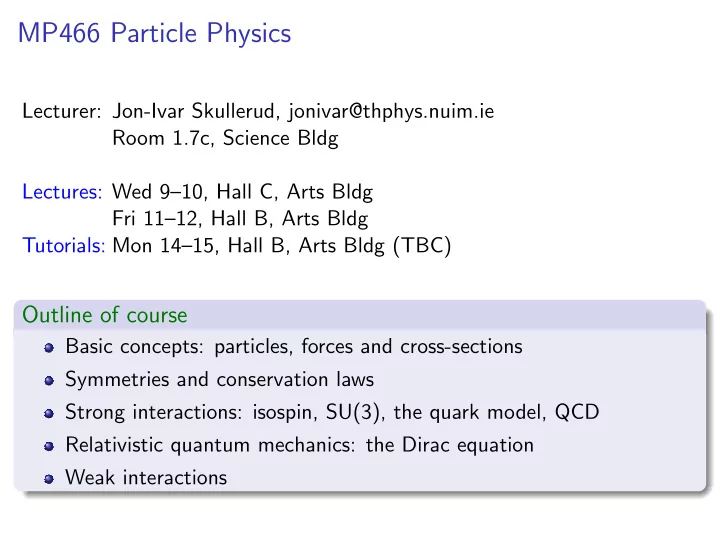

MP466 Particle Physics Lecturer: Jon-Ivar Skullerud, jonivar@thphys.nuim.ie Room 1.7c, Science Bldg Lectures: Wed 9–10, Hall C, Arts Bldg Fri 11–12, Hall B, Arts Bldg Tutorials: Mon 14–15, Hall B, Arts Bldg (TBC) Outline of course Basic concepts: particles, forces and cross-sections Symmetries and conservation laws Strong interactions: isospin, SU(3), the quark model, QCD Relativistic quantum mechanics: the Dirac equation Weak interactions
Recommended books M. Thomson, Modern Particle Physics, (2013) Cambridge University Press A. Bettini, Introduction to Elementary Particle Physics, 2nd Edition (2014) Cambridge University Press Online course material is at http://www.thphys.nuim.ie/Notes/MP466/ Assessment Continuous assessment (5 assignments) 20% Exam 80% Assignments are compulsory!
What is a particle? Common prejudices: 1 Particles are localisable 2 Particles carry energy and momentum 3 Particles have definite masses 4 Particles have definite charges, spins and other quantum numbers Heisenberg’s uncertainty relation gives conflict between the first two ∆ x ∆ p x ≥ � 2 Mathematical definitions A particle is an excitation of a quantum field A particle is an irreducible representation of the Poincar´ e group
Classification of particles Bosons and fermions If 1 and 2 are identical particles, then ψ (1 , 2) = ± ψ (2 , 1) +: bosons − : fermions Spin–statistics theorem: boson/fermion ← → intrinsic angular momentum bosons: S = n � S = ( n + 1 fermions: 2 ) � Stable and unstable r , t ) = Ne i ( � p · � r − Et ) / � Free particle wavefunction Ψ( � We see that | Ψ(0 , t ) | 2 = constant — stable particle Some particles are unstable: | Ψ(0 , t ) | 2 = N 0 e − t /τ This corresponds to a complex energy
The four forces 1 Electromagnetism — affects everything with (electric) charge ◮ Responsible for all of chemistry and material properties e 2 ◮ Strength α = 1 4 πǫ � c ≈ 137 2 Strong force — affects everything with colour charge ◮ Responsible for keeping quarks together in protons and neutrons ◮ Responsible for keeping nuclei together ◮ Strength α s = g 2 4 π ∼ 0 . 3 s 3 Weak force — affects all known particles ◮ Responsible for some radioactive processes, eg β decay ◮ Strength α W = g 2 4 π ∼ 0 . 034 W 4 Gravity — affects everything with energy/momentum ◮ Responsible for keeping planets, stars, galaxies together ◮ Responsible for expansion of the universe ◮ No quantum theory of gravity known ◮ Negligible on (sub)atomic scale In quantum description, all fields have quantised excitations: γ, g , W ± , Z 0 — all spin 1 (hypothetical graviton would be spin 2)
Matter particles Elementary matter constituents Leptons e , µ, τ, ν e , ν µ , ν τ Quarks u , d , s , c , b , t Elementary particles are described as point particles (mathematical points) Hadrons Bound states of quarks (and gluons) Mesons: bosons — π, ρ, K , η, J /ψ, D , B , . . . Baryons: fermions n , p , Σ , Ξ , Λ , Ω , . . . Hadrons have a size ∼ 1 fm (10 − 15 m)
Higgs field The Higgs field and its associate particle does not fit neatly into matter–force classification Spin 0 (scalar boson) The field as a nonzero expectation value in the vacuum (vev) Coupling of vev to elementary particles behaves like a mass for those particles (Brout–Englert–Higgs mechanism)
Energy scales
Recommend
More recommend